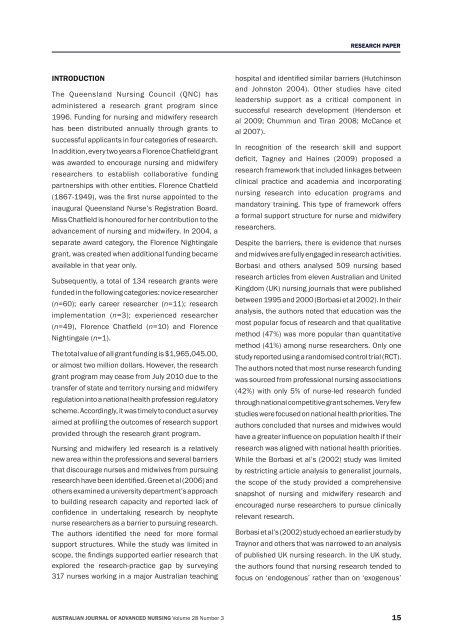australian journal of advanced nursing
australian journal of advanced nursing
australian journal of advanced nursing
You also want an ePaper? Increase the reach of your titles
YUMPU automatically turns print PDFs into web optimized ePapers that Google loves.
INTRODUCTION<br />
The Queensland Nursing Council (QNC) has<br />
administered a research grant program since<br />
1996. Funding for <strong>nursing</strong> and midwifery research<br />
has been distributed annually through grants to<br />
successful applicants in four categories <strong>of</strong> research.<br />
In addition, every two years a Florence Chatfield grant<br />
was awarded to encourage <strong>nursing</strong> and midwifery<br />
researchers to establish collaborative funding<br />
partnerships with other entities. Florence Chatfield<br />
(1867‑1949), was the first nurse appointed to the<br />
inaugural Queensland Nurse’s Registration Board.<br />
Miss Chatfield is honoured for her contribution to the<br />
advancement <strong>of</strong> <strong>nursing</strong> and midwifery. In 2004, a<br />
separate award category, the Florence Nightingale<br />
grant, was created when additional funding became<br />
available in that year only.<br />
Subsequently, a total <strong>of</strong> 134 research grants were<br />
funded in the following categories: novice researcher<br />
(n=60); early career researcher (n=11); research<br />
implementation (n=3); experienced researcher<br />
(n=49), Florence Chatfield (n=10) and Florence<br />
Nightingale (n=1).<br />
The total value <strong>of</strong> all grant funding is $1,965,045.00,<br />
or almost two million dollars. However, the research<br />
grant program may cease from July 2010 due to the<br />
transfer <strong>of</strong> state and territory <strong>nursing</strong> and midwifery<br />
regulation into a national health pr<strong>of</strong>ession regulatory<br />
scheme. Accordingly, it was timely to conduct a survey<br />
aimed at pr<strong>of</strong>iling the outcomes <strong>of</strong> research support<br />
provided through the research grant program.<br />
Nursing and midwifery led research is a relatively<br />
new area within the pr<strong>of</strong>essions and several barriers<br />
that discourage nurses and midwives from pursuing<br />
research have been identified. Green et al (2006) and<br />
others examined a university department’s approach<br />
to building research capacity and reported lack <strong>of</strong><br />
confidence in undertaking research by neophyte<br />
nurse researchers as a barrier to pursuing research.<br />
The authors identified the need for more formal<br />
support structures. While the study was limited in<br />
scope, the findings supported earlier research that<br />
explored the research‑practice gap by surveying<br />
317 nurses working in a major Australian teaching<br />
RESEARCH PAPER<br />
hospital and identified similar barriers (Hutchinson<br />
and Johnston 2004). Other studies have cited<br />
leadership support as a critical component in<br />
successful research development (Henderson et<br />
al 2009; Chummun and Tiran 2008; McCance et<br />
al 2007).<br />
In recognition <strong>of</strong> the research skill and support<br />
deficit, Tagney and Haines (2009) proposed a<br />
research framework that included linkages between<br />
clinical practice and academia and incorporating<br />
<strong>nursing</strong> research into education programs and<br />
mandatory training. This type <strong>of</strong> framework <strong>of</strong>fers<br />
a formal support structure for nurse and midwifery<br />
researchers.<br />
Despite the barriers, there is evidence that nurses<br />
and midwives are fully engaged in research activities.<br />
Borbasi and others analysed 509 <strong>nursing</strong> based<br />
research articles from eleven Australian and United<br />
Kingdom (UK) <strong>nursing</strong> <strong>journal</strong>s that were published<br />
between 1995 and 2000 (Borbasi et al 2002). In their<br />
analysis, the authors noted that education was the<br />
most popular focus <strong>of</strong> research and that qualitative<br />
method (47%) was more popular than quantitative<br />
method (41%) among nurse researchers. Only one<br />
study reported using a randomised control trial (RCT).<br />
The authors noted that most nurse research funding<br />
was sourced from pr<strong>of</strong>essional <strong>nursing</strong> associations<br />
(42%) with only 5% <strong>of</strong> nurse‑led research funded<br />
through national competitive grant schemes. Very few<br />
studies were focused on national health priorities. The<br />
authors concluded that nurses and midwives would<br />
have a greater influence on population health if their<br />
research was aligned with national health priorities.<br />
While the Borbasi et al’s (2002) study was limited<br />
by restricting article analysis to generalist <strong>journal</strong>s,<br />
the scope <strong>of</strong> the study provided a comprehensive<br />
snapshot <strong>of</strong> <strong>nursing</strong> and midwifery research and<br />
encouraged nurse researchers to pursue clinically<br />
relevant research.<br />
Borbasi et al’s (2002) study echoed an earlier study by<br />
Traynor and others that was narrowed to an analysis<br />
<strong>of</strong> published UK <strong>nursing</strong> research. In the UK study,<br />
the authors found that <strong>nursing</strong> research tended to<br />
focus on ‘endogenous’ rather than on ‘exogenous’<br />
AUSTRALIAN JOURNAL OF ADVANCED NURSING Volume 28 Number 3 15

















